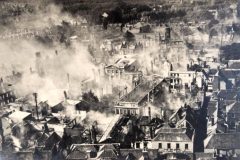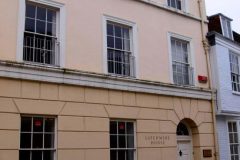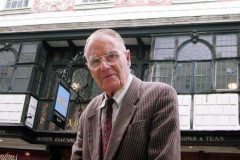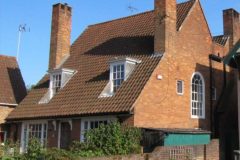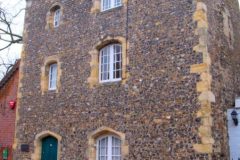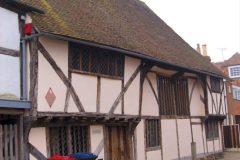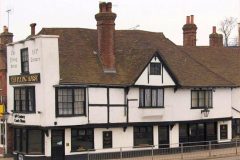Architect & Conservationist
Architect Anthony Swaine helped to save Canterbury twice – as an air raid protection warden in the Second World War dealing with the “enemy without” and after the war from the planners he called “the arrogant enemy within”.
Swaine grew up in Thanet, on the east Kent coast and his step grandfather, a retired clergyman, inspired his love of buildings, particularly churches. In 1931, aged 18, he joined the office of Harold Anderson, the architect for Canterbury Cathedral, and was the cathedral’s clerk of the works during the Second World War. On June 1, 1942, the morning after the “Baedeker Raid” on Canterbury he took a photograph (Image 1) from the top of Bell Harry tower of the ruins of the city’s Whitefriars district. He said: “Many buildings, although damaged, were left standing and capable of repair; however, while the ashes and cinders were still warm, the evil act of matricide was about to begin.” The city authorities were under instructions even to clear buildings that could have been repaired.
Near the end of the war a city-wide reconstruction plan was drawn up which involved demolishing many properties untouched by the bombing. Swain was a founder committee member of the Canterbury Citizens’ Defence Association formed to fight the plan. Although the plan’s full implementation was halted, over the following decades buildings were demolished that he thought repairable and worth saving.
After the war Swain set up his own practice in Latchmere House (Image 2), Watling Street, a house dating from 1620 which he had restored. He was much involved with the War Damages Commission and visited other devastated cities on the European mainland. After the 1966 Venice floods he helped with restoration and used knowledge gained there to save the crumbling 17th Century exterior plasterwork on Queen Elizabeth’s Guest Chamber (Image 3) in the High Street. In more than 60 years of his own practice he oversaw the restoration of many historic buildings in Canterbury and elsewhere and he worked on conservation projects for whole areas, particularly in Faversham, Deal and Margate. He also designed new buildings, for instance an arts and crafts style house (Image 4) in St Augustine’s Road, replacing a 1911 home destroyed in the war.
Swaine received the first Lifetime Achievement award from the Royal Institute of British Architects and was made a freeman of Canterbury. He carried on working, until a few days before his death aged 99, in April 2013, although by then it was just one day a week. In 1998 his practice had had to leave Latchmere House and the city council offered him Bastion Tower (Image 5), Pound Lane, which Swaine had helped to restore and where the practice bearing his name and principles continued after his death. His funeral was held in the cathedral.
He once wrote: “I like the charm of an old wall or a roof that sags slightly. But the appeal of working with ancient buildings and being concerned with conservation areas is not just about architecture, but about the people who built it. I sometimes wonder what they were like and what was in their medieval minds.”
Some of the many other buildings Swaine worked on:
- Eastbridge Hospital
- Greyfriars
- Poor Priests’ Hospital
- St Mildred’s church
- St Peter’s church
- 15th Century hall, Ivy Lane (Image 6)
- Flying Horse pub, Dover Street (Image 7) – has now become the Corner Restaurant
Sources: Kentish Gazette (1945-2013); Anthony Swain collection, Kent History and Library Centre, Maidstone; “Arthur Swaine And Conservation In East Kent”, by Richard Morrice, pp31-42 in Twentieth Century Architecture 7, 2004; “Too busy enjoying the job to retire at 91” by Anthony Swaine, Building.co.uk, 22 October 2004.
JPD

